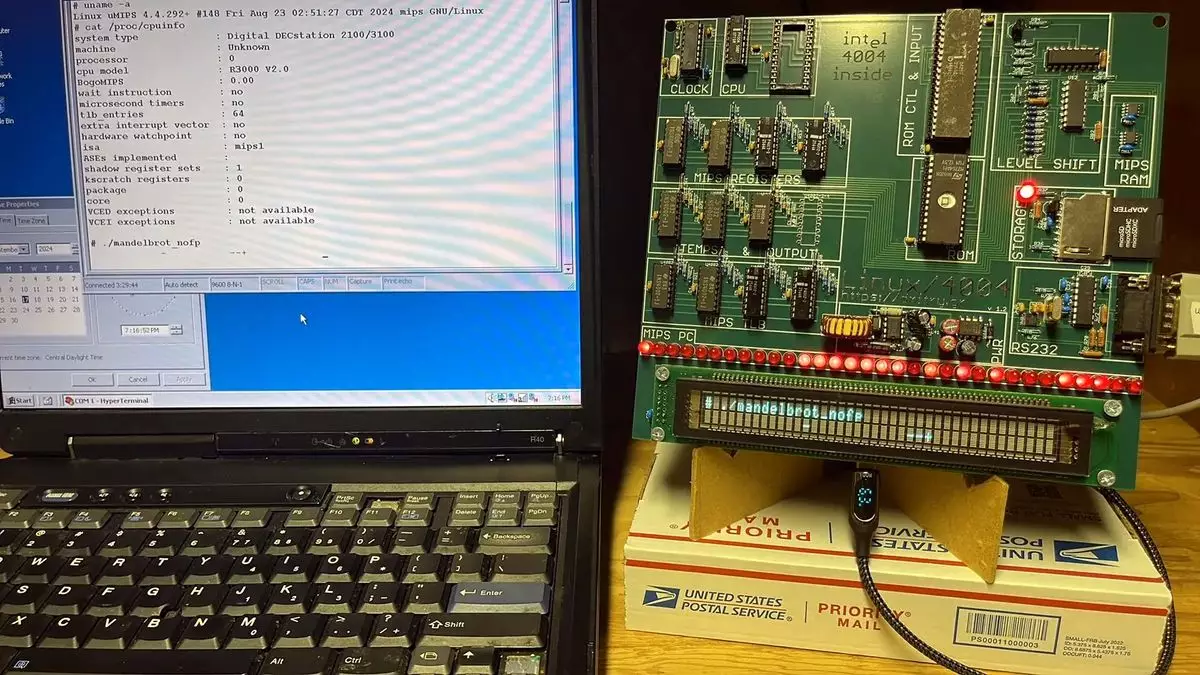The world of computing has seen incredible advances since the first microprocessors made their debut. Yet, the heart of technology often lies not just in progress, but in the exploration of its origins. Dmitry Grinberg, a talented engineer known for his ambitious projects, recently undertook a unique challenge by running Debian Linux—the operating system that emerged over three decades ago—on a processor that hadn’t been relevant for nearly half a century: the 4-bit Intel 4004, released in 1971. This endeavor not only blurs the lines between past and present but also illustrates the lengths to which the human spirit will go to explore the seemingly impossible.
The Intel 4004 is often lauded for being the first commercially successful microprocessor. However, by modern computing standards, it is tremendously crude, featuring just 2,600 transistors. Its functionalities are remarkably restricted—it primarily performs basic arithmetic operations and lacks hardware support for logic operations. Furthermore, multitasking, a staple in modern computing, is hindered due to its inability to handle interrupts. Essentially, the Intel 4004 defines the term “barebones” in computing, making Grinberg’s project one defined by extreme constraints.
Yet, rather than deterring his efforts, these limitations sparked Grinberg’s creativity. He faced a monumental challenge: how to get an operating system as complex and feature-rich as Linux to boot on such an antiquated chip. The answer lay in a radical approach to emulation. By coding an emulation of a MIPS R3000 processor, which was contemporaneously relevant to the early Linux kernel, Grinberg creatively expanded the potential of the aged microprocessor.
Grinberg’s solution wasn’t merely about wiring together older technology; it involved a deep understanding of both the Intel 4004’s architecture and the requirements of running Linux. He assembled an intricate custom circuit board complete with period-appropriate hardware components. By harnessing a synthesized environment where the 4004 could emulate a much more advanced processor, he set a stage for Linux to go live.
Despite the ingenuity behind his setup, he still confronted a significant hurdle: speed. The Intel 4004’s clock operates at a mere 790 kHz. Even with a 5% overclock, the processor’s sluggishness became a glaring bottleneck, leading initial estimates of boot time to reach an astonishing nine days. Through relentless tweaking and optimizations, Grinberg managed to reduce this astounding figure down to approximately 4.76 days. Watching the kernel boot in real time may seem unbearable, yet it demonstrated a commitment to seeing a dream realized in the most unconventional manner.
While this project carries no tangible benefits in the realm of practical applications, it stands as a monument to human ingenuity. With each limitation encountered, Grinberg’s project echoes a common theme found in the annals of technological advancement: the drive to innovate against all odds. This artistic and technical endeavor entwines the nostalgia of computer history with the relentless pursuit of knowledge.
Grinberg’s work serves to inspire a multitude of individuals passionate about computing and engineering. It exemplifies that boundaries, often perceived as strict limits, can be transformed into creative catalysts for innovation. Furthermore, it affirms that even software seemingly intended for powerful modern machines can find a new home in the simplest framework imaginable.
One must ponder what awaits Grinberg after achieving such a monumental task. Will the next challenge involve something equally ambitious, perhaps an iconic game like Doom running on an equally obsolete platform? The possibilities are as expansive as the imagination permits. As technology continues to evolve, projects of this nature remind us that exploring the frontiers of computing is often about revisiting the past and redefining limitations.
Grinberg’s journey into retro-computing demonstrates not only technical prowess but also the profound connection between technology and its history. His determination to make the impossible possible inspires not only future engineers but anyone striving to push the boundaries of what can be achieved.

